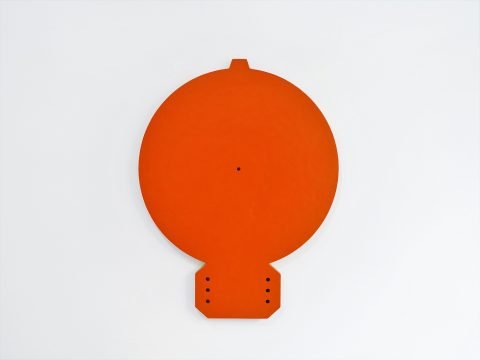Michael Rey at ZERO… gallery: “The uncanny is not something you can produce at will”
- Michael Rey, HELIOPOKA, 2016; oil on plasticine clay on panel 127 x 142 cm.
- Michael Rey, Plydis Kave, installation view at ZERO… gallery, Milan.
- Michael Rey, Viklp (Alo-Fiej), 2016; oil on plasticine clay on panel, 81 x 162 cm.
- Michael Rey, OBIMLEB, 2016; oil on plasticine clay on panel, 122 x 118 inches.
- Michael Rey, OBIMLEB, 2016; detail.
- Michael Rey, Plydis Kave, installation view at ZERO… gallery, Milan.
- Michael Rey, VUNNIAB, 2016; oil on plasticine clay on panel, 94 x 122 cm.
We had never visited his studio, met him in person, or read any article about him before. When a few days ago we entered Michael Rey’s current solo exhibition at ZERO… gallery in Milan we were almost pure to his thick surfaces, flat colours, and emblematic shapes. Almost; actually we had saw them in the flesh for the very first time in June 2015, in Basel, in the context of an art fair (Liste), but that was a quite punitive way to get in touch with Rey’s poetics. On the contrary, last Thursday the exhibition space was empty, quiet and welcoming like a small church in the countryside, and it took no effort to carefully read the effective interview that the artist has given for the occasion to the Los Angeles-based writer Mario Cutajar.
Printed on a plain white sheet of paper and available at the entrance, the writing is clearly intended to provide the reader with some crucial info regarding the artist’s bio and artistic practice. You learn the he has a “genuinely” working class background and that he considers painting what could actually be more sculptural than pictorial. He is comfortable with carpentry tools and techniques at the point that he can use them to “draw” his flat volumes, while wood-shops and metal-shops have been his favourite playground since he was a teenager. As any clever artist who manages monochromatic surfaces, form Barnett Newmann to Gotthard Graubner, Rey knows the importance of edges and refuses to leave traces (even if the residual painting on the side could be regarded as something expressing the making process). He also prefers to avoid references, and that would be enough to make him a powerful artist. But the passage of the interview that really brought us into the core of the matter is the following:
I’m looking to surprise myself. What I am looking for is something uncanny, something unfamiliar. That’s why I have to do a lot of drawing to get anywhere. The uncanny is not something you can produce at will. You have to get over your own “natural” impulses, which can be derivative. I also have to work to avoid anthropomorphic references. If things become like claws or hands or faces or crosses, some kind of recognizable thing, I become wary.
On a psychological basis we totally agree with the artist. Once you become aware of your “natural” impulses and biases you try to control them, especially when they are potentially dangerous for you. It may happen when you read a book which deals with how we see, or behave, or make decisions. It leads you to think about yourself as if you were someone else observing you from the outside of your body and mind. We had this same feeling while watching Rey’s pieces. The “uncanny” emerges from controlling shape and colour and it is the result of a precise, perhaps scientific, selective process. We improve our behaviour when we know more about how we behave. Hence we found ourselves mirrored in this well-balanced expression of control.
On a psychological basis, again; since the gallery was empty and quiet, we were be able to ask to the gallery owner to show us the back of some of the works and we realised that when Rey says that he can “draw” with carpentry tools and techniques he definitely tells the truth. The verso of Rey’s pieces is as controlled as their recto and it generally includes two grips designed in order to make it easy to handle it without touching the delicate oil on plasticine pictorial surface. It is practical issue, but it’s also something that we may read as an additional and perhaps lateral element proving the artist’s mentality.
“Corporate logo” says at some point Mario Cutajar. “Sure, a corporate logo, or any number of things” replies Rey. Abstraction works better when open to interpretation. The beholder is free to link colour and shape to his own stereotypes and potentially become aware of these latter thanks to the work of art, which acts as a mind trigger. Also the titles Rey is used to give to his pieces go in this direction. They look like ordinary titles, using ordinary words, but they are something else. Letters are not making any word in any language, and don’t even suggest the existence of a secret one only the artist knows. They just look familiar, or readable, but in fact they are mere sequences of signs and spaces. How stimulating could be living in a city and not understanding its language?
November 25, 2020







